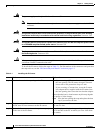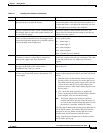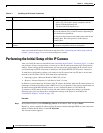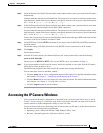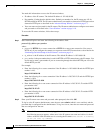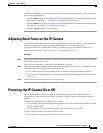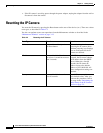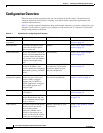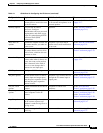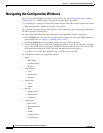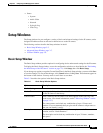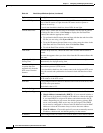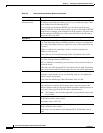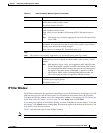
3-2
Cisco Video Surveillance System IP Camera User Guide
OL-14220-01
Chapter 3 Configuring and Managing the IP Camera
Configuration Overview
Configuration Overview
There are many settings and options that you can configure for the IP camera. The items that you
configure depend on several factors, including your camera model, operational requirements, and
connected external devices.
Table 3-1 provides general information to help you determine what items you need to configure for your
situation. Use this table as a guide as you configure your IP camera and as a reference if you need to
change configurations in the future.
Table 3-1 Guidelines for Configuring the IP Camera
Configuration Item Explanation Guidelines for Use Reference
IP camera name and
description
Identifies the IP camera. Recommended. See the “Basic Setup Window”
section on page 3-5.
LED operation Determines whether the LEDs
on the front of the IP camera
light or remain off.
Optional. See the “Basic Setup Window”
section on page 3-5.
Time information Sets the date and time for the IP
camera. Also determines how the
IP camera obtains the date and
time, its time zone, and whether
it adjusts for daylight saving
time.
Recommended. See the “Basic Setup Window”
section on page 3-5.
Network options Determine how the IP camera
obtains its IP address, and
provides options for configuring
subnet mask, gateway, and DNS
servers.
IP address is required if DHCP is
not enabled in your network,
other items depend on your
network configuration.
See the “Basic Setup Window”
section on page 3-5.
Advanced network
and protocol options
Determine whether the IP
camera uses Cisco Discovery
Protocol (CDP), configure
alternate ports for HTTP or
HTTPS connections, configure
RTP or RTSP options, and
configure QoS.
Optional, depending on your
network and requirements.
See the “Advanced Setup
Window” section on page 3-7.
IP address filters Controls access to the IP camera
by IP address.
Optional. See the “IP Filter Window”
section on page 3-9.
IP camera users Sets the password for the IP
camera administrator, and sets
log in credentials and privileges
for up to 20 users.
Optional. See the “Users Window” section
on page 3-10.
Video options Sets video resolution and quality,
whether you use one or two
video streams, picture
appearance, whether video
includes a time stamp or text
overlay, and how the IP camera
handles day and night modes.
Optional, depending on your
requirements.
See the “Video Window” section
on page 3-14.



